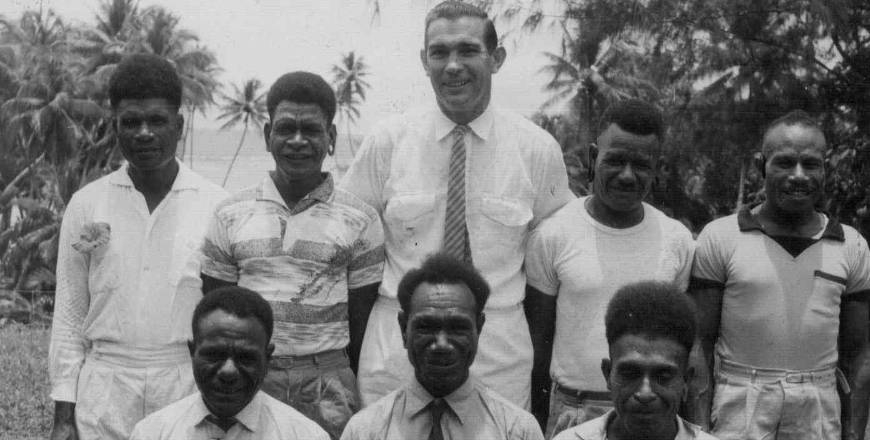Australian Lutheran men and women played a major role in mission work on the islands of Siassi in New Guinea. This year 2011 is the 75th anniversary of the Australian Lutheran Mission, which was set up by the Evangelical Lutheran Church of Australia (ELCA) in 1936 to send missionaries to the Sepik River area in […]
Australian Lutheran men and women played a major role in mission work on the islands of Siassi in New Guinea.
This year 2011 is the 75th anniversary of the Australian Lutheran Mission, which was set up by the Evangelical Lutheran Church of Australia (ELCA) in 1936 to send missionaries to the Sepik River area in New Guinea.
But the Siassi story begins much earlier. For this year also marks the centenary of Lutheran mission work on Siassi, as well as the 125th anniversary of Lutheran mission work in Papua New Guinea (PNG).
The third German Lutheran missionary to join missionary Flierl in his fledgling Lutheran Mission Finschhafen was Rev Georg Bamler. When he was stationed on Tami Island he came into contact with the inhabitant’s trading partners, the Tuam Islanders. This led Bamler, together with Iayman Wahnes, to go to Tuam, where they spent six weeks exploring the Rooke-Siassi islands by canoe and on foot. They returned home on a Tami trading canoe across the often treacherous open waters of the Vitiaz Strait.
On 28 April 1911 Bamler arrived at the Rooke-Siassi islands on the mission schooner Bavaria to start a mission station on the south-eastern side of Rooke Island, the large island of the group. It was an isolated place and Bamler once noted that he went for nine months with no contact with the outside world. The first baptisms were at Tuam in 1914. Later he established a permanent station at Karapo, where tragically he was killed by a falling tree on 12 November 1928. Then followed vacancies, short stays by two missionaries and the relocation of the mission station to Awelkon on the western side of Rooke Island.
Now we return to the Australian Lutheran Mission (ALM) story. In January 1936 the first four missionaries, Rev APH Freund, Rev FW Noack, and laymen Vic Neumann and Gerald Noack, attended the Lutheran Mission Finschhafen (LMF) annual conference. LMF was being challenged to extend their mission work into the central highlands behind their coastal mission stations. The LMF conference therefore decided to sell the Rooke-Siassi field to ALM, including all its building and stock. The evangelists and teachers were part of the package, too. For the young and inexperienced missionaries this seemed ideal for gaining experience and preparing local men as teachers and evangelists to further the Sepik mission plan.
So ‘Our New Guinea Mission’ came into being on 22 October 1936, when these missionaries took residence at Awelkon on Rooke Island. Later the title, ‘The Australian Lutheran Mission New Guinea’, was adopted. At that time Siassi had a population of 6000, including 1500 baptised Christians, thirteen local teachers, seven evangelists, several hundred pupils in village schools and 45 boys in the Awelkon school. Two years later ALM purchased the Gizarum Plantation.
During World War II mission activity ceased. Three mission staff (Freund, Zacher and Neumann) joined the New Guinea Volunteer Rifles and everyone else was evacuated. Post-war re-establishment began in 1947 with the return of Freund and Neumann and the arrival of three new missionaries, Rev Con Eckermann, Rev Keith Nagel and layman Pat Kleinig.
Education and health on Siassi took a giant step forward with the opening of Gelem Training Centre in 1949 under Eckermann, and with the employment of nurses. In 1951 Nagel established a new station with a hospital at Lablab on the eastern side of Rooke Island. Gelem moved into primary and secondary education, while the other missionaries (Nagel and Kleinig) training pastors. When new mission areas on the mainland were started at Wabag and Menyamya, Siassi teachers and evangelists were used with great success.
Leaders began to emerge, like Pastor Yasaking Yawal, the first president of the fledgling Siassi Lutheran Church which was formed in 1964. As self-government and independence came, many Siassis were well situated to take up key positions in government, church, health, education, business, industry and politics across the country.
In the 1970s the mission era ended decisively. Independence and the dissolution of Australian Lutheran Mission occurred in 1975, and in 1976 the Siassi Lutheran Church became the 7th District of Evangelical Lutheran Church of New Guinea (now Evangelical Lutheran Church-PNG). In 1975 the ownership of Gizarum land was in dispute and the government awarded the lease to the Siassi church. They sold the plantation in 1981. The last expatriate missionary on Siassi, Rev Cecil Logan, left in 1990. The original Sepik dream was never realised.
Over the last hundred years 81 Australians were employed by the mission to work on Siassi. Wives contributed immensely to the mission work in many capacities, but the policy was that they were never employed or paid. So if we count the unpaid wives and volunteers, the number of Australians who have served on Siassi over the years far exceeds 100. They will celebrate this 75th anniversary in Adelaide on 15, 16 October.
God has blessed Siassi. We are their parent church and they look to us for an ongoing supportive partner relationship. The Lutheran Church of Australia has unfinished business on Siassi.
Many of our partner churches are working in new territory for the kingdom of God; therefore, spiritual attack is their everyday reality. As a member of a congregation, school, or family, or a couple or individual, you are invited to commit to praying for our partners in mission. For regular prayer point updates, go to www.lca.org.au/international-mission/act-now/pray
Read more stories about our partner church in Papua New Guinea at https://www.lcamission.org.au/category/stories/international-partners/papua-new-guinea/


0 Comment